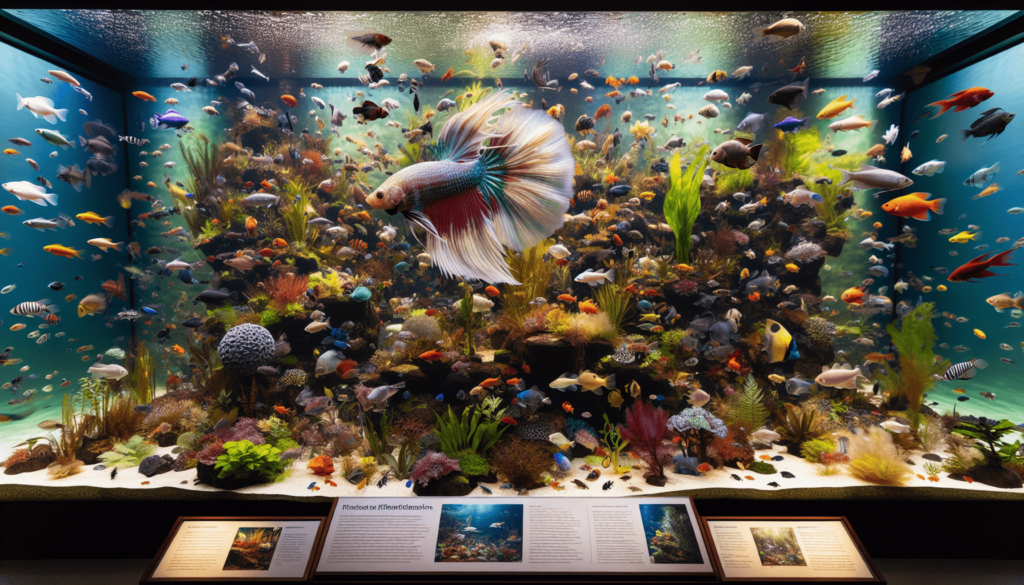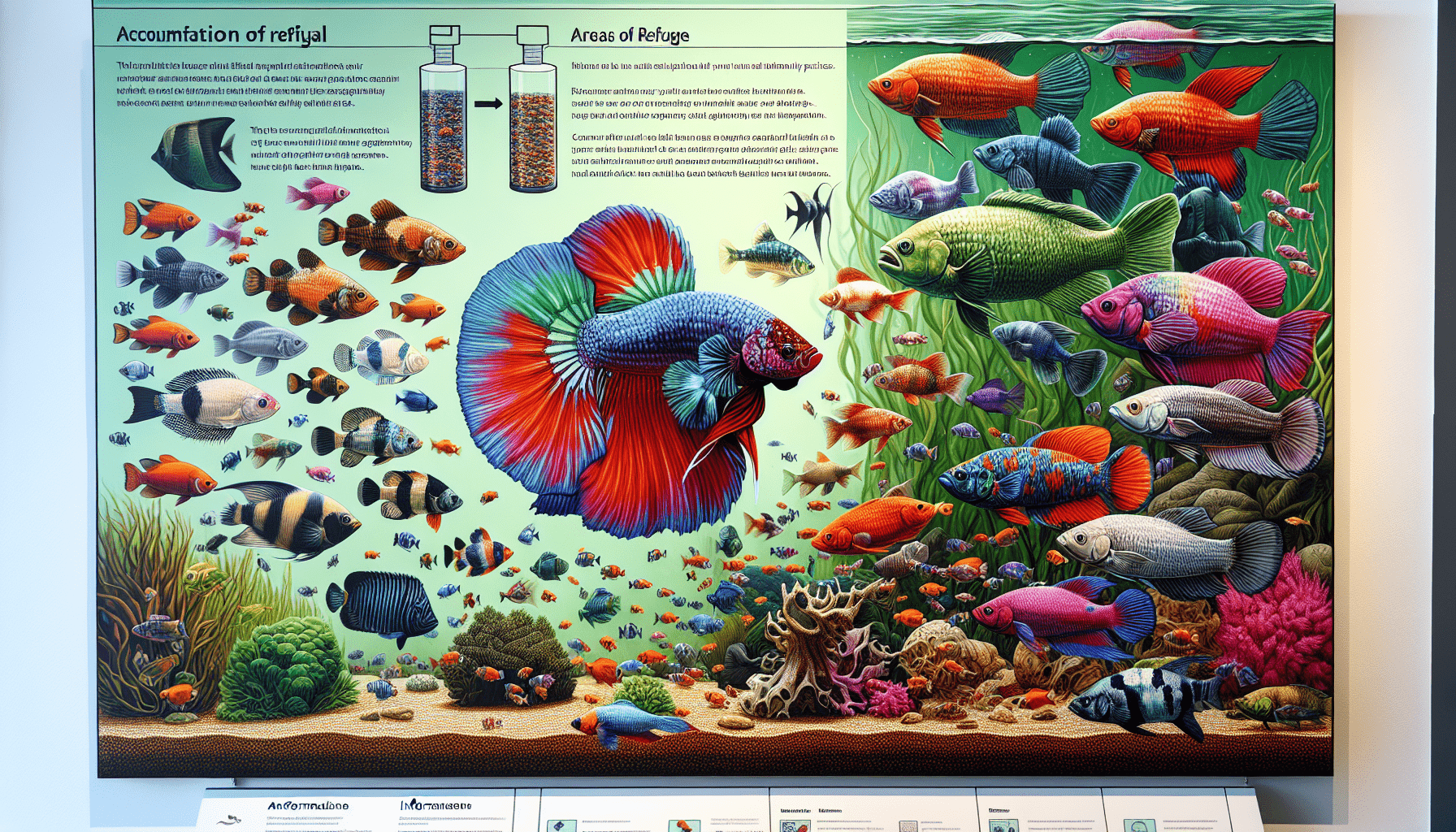Have you ever wondered if your Betta fish can coexist peacefully with other fish? Well, you’re in luck because in this article, we will explore the fascinating topic of whether Betta fish can live harmoniously with other fish species. Many aquarium enthusiasts are often curious about this, as Betta fish are known for their stunning beauty and captivating personality. So, sit back, relax, and let’s dive into the world of Betta fish and their potential tank mates.
Compatible Fish for Betta Fish
Betta fish, also known as Siamese fighting fish, are beautiful and charismatic aquatic pets. While bettas are known for their striking colors and flowing fins, there is a common misconception that they are solitary creatures that cannot live with other fish. However, with careful consideration and proper tank setup, bettas can indeed coexist with certain fish species in a community tank. In this article, we will explore the factors to consider when selecting tank mates for betta fish, discuss compatible fish for both male and female bettas, and provide tips on introducing new tank mates to ensure a harmonious aquarium environment.
Factors to Consider
When considering tank mates for betta fish, there are several factors that need to be taken into account. These factors include the tank size, water parameters, and aggression level of both the betta and potential tank mates.
Tank Size
One crucial aspect to consider when keeping bettas with other fish is the size of the tank. The minimum recommended tank size for a betta fish is 5 gallons, but a larger tank is always better. In a smaller tank, such as a 5-gallon, it may be more challenging to maintain proper territories and provide adequate hiding spots for both the betta and its tank mates. A larger tank with plenty of hiding places and swimming spaces will help reduce stress and aggression among the fish.
Water Parameters
It is essential to ensure that the water parameters required by the betta and potential tank mates are similar. Bettas prefer warm water with a temperature ranging from 76 to 82 degrees Fahrenheit. However, some species of fish may have different temperature preferences or require specific pH levels and water hardness. It is crucial to research the specific care requirements of each fish species and choose tank mates that can thrive in similar conditions.
Aggression Level
Betta fish, particularly male bettas, are well-known for their territorial and aggressive behavior. Therefore, it is crucial to choose tank mates that are compatible with their aggression level. Fish with long, flowing fins or bright colors can sometimes trigger aggression in bettas, as they may mistake them for rival males. Selecting fish with short fins and a peaceful temperament is generally a safer choice.

Female Betta Fish
Keeping female betta fish together or with other fish can be a successful endeavor if certain conditions are met. Female bettas are generally less aggressive and territorial than their male counterparts, making them more compatible with tank mates.
Keeping Female Betta Fish Together
Female bettas can be housed together in groups called “betta sororities.” However, it is essential to have a spacious tank with plenty of hiding spots and visual barriers to minimize aggression. A tank size of at least 20 gallons is recommended for a sorority, with a minimum of four to five female bettas. Adding more females can help spread out aggression and reduce the chances of one betta being singled out.
Keeping Female Betta with Other Fish
When considering other fish as tank mates for female bettas, it is crucial to choose species that are peaceful and not prone to fin-nipping. Avoid fish with long, flowing fins or bright colors that might trigger aggression. Good tank mates for female bettas include peaceful community fish such as tetras, rasboras, and Corydoras catfish. Always monitor the interactions between the bettas and other fish to ensure harmony and address any signs of aggression.
Male Betta Fish
Male betta fish are renowned for their vibrant colors and flowing fins. They require more careful consideration when selecting tank mates due to their territorial and aggressive nature. While it is generally not recommended to keep two male bettas together, they can peacefully coexist with some fish species under specific conditions.
Keeping Male Betta Fish Together
Keeping two male bettas together in the same tank is highly discouraged, as they will most likely engage in aggressive battles, potentially leading to severe injuries or even death. Male bettas are solitary fish by nature and prefer to have their own territories. It is essential to provide each male betta with its separate tank to ensure their well-being.
Keeping Male Betta with Other Fish
If you wish to introduce tank mates to a male betta’s aquarium, it is crucial to consider their compatibility and minimize the risk of aggression. Ideal tank mates for male bettas are small, peaceful fish that do not resemble male bettas. Some suitable options include small tetras, danios, and peaceful bottom-dwelling fish like dwarf corydoras or kuhli loaches. Avoid fish with long, flowing fins or aggressive tendencies that may trigger the betta’s territorial instincts.

Community Tanks
Creating a peaceful community tank that includes betta fish requires careful planning and consideration. A harmonious community tank can provide an enriching environment for all the inhabitants and showcase the natural beauty of bettas alongside compatible tank mates.
Creating a Peaceful Community Tank
To create a peaceful community tank, start by ensuring that the tank size meets the requirements for all the fish species involved. A well-sized tank with plenty of hiding spots, plants, and decorations will allow each fish to establish their territory and reduce aggression. It is essential to maintain excellent water quality by performing regular water changes and monitoring the water parameters.
Ideal Tank Mates for Betta Fish
The ideal tank mates for betta fish include peaceful, schooling fish that are compatible with the betta’s water requirements and temperament. Small tetras such as neon tetras, ember tetras, or harlequin rasboras are often great choices. Other compatible options include peaceful livebearers like guppies or endlers, as well as dwarf or pygmy Corydoras catfish.
Common Community Fish That Make Good Tank Mates
Several common community fish species make excellent tank mates for betta fish. Some of these species include platies, swordtails, mollies, cherry or ghost shrimp, and small catfish like otocinclus or bristlenose plecos. When selecting tank mates, always research their specific care requirements and behavior to ensure compatibility with the betta fish.
Aggressive Tank Mates
In a community tank, it is crucial to avoid aggressive fish species that could harm or stress out the betta fish. Certain fish are known to have aggressive tendencies or may perceive the betta as a threat, leading to aggressive behavior.
Aggressive Fish Species to Avoid
Fish with a reputation for aggression, such as cichlids or aggressive barbs, should be avoided when selecting tank mates for bettas. Avoid large, territorial fish that may harm or outcompete the betta, as well as fin-nipping species.
Fish Known to Attack Betta Fish
Certain fish species have a higher likelihood of attacking or harassing betta fish. These species include tiger barbs, some gouramis, or larger aggressive catfish like pictus catfish. Always research the behavior and compatibility of potential tank mates to minimize the risk of aggression towards the betta fish.
Non-Fish Tank Mates
While betta fish are mainly kept in aquariums with other fish, it is also possible to have compatible non-fish tank mates that can add diversity to the aquarium setup.
Compatible Non-Fish Tank Mates for Betta Fish
Some suitable non-fish tank mates for betta fish include snails and shrimp. Apple snails or Malaysian trumpet snails can help keep the tank clean by consuming debris and algae. Cherry shrimp or ghost shrimp add a lively presence to the aquarium while being generally peaceful. Always consider the specific care requirements of these non-fish tank mates and ensure that they can coexist harmoniously with the betta fish.
Introducing New Tank Mates
When introducing new tank mates to an existing betta fish aquarium, it is crucial to follow a proper acclimation process and closely monitor the behavior of all the fish.
Proper Acclimation Process
When adding new fish to a tank with an established betta, it is important to acclimate them gradually to minimize stress and prevent any sudden aggression. Float the bag containing the new fish in the tank for around 10-15 minutes to equalize the water temperature. Then, open the bag and add small amounts of tank water to the bag every few minutes. After about 30 minutes, gently release the fish into the tank, preferably during the evening when the betta is less active.
Monitoring Behavior
After introducing new tank mates to the betta fish aquarium, closely monitor their behavior for any signs of aggression or stress. Watch for chasing, fin-nipping, or any signs of physical damage to the fish. If any aggression is observed, it may be necessary to separate the aggressive individual to ensure the safety and well-being of all the tank inhabitants.
Separating Aggressive Individuals
If aggression becomes a persistent issue between the betta fish and their tank mates, it may be necessary to take measures to separate the aggressive individuals within the aquarium.
Setting Up Dividers in the Tank
One effective way to separate aggressive individuals is by using tank dividers. Dividers can be placed within the aquarium to create separate territories for the betta and its aggressive tank mate. The dividers should be secure and prevent any physical contact between the fish while still allowing water circulation.
Observing for Signs of Aggression
Continuously observe the interactions between fish in the tank, especially if aggression has been previously observed. Watch for any signs of stress, damage, or persistent chasing. If aggression persists despite attempts to separate the individuals, it may be necessary to rehome one of the aggressive fish to ensure the well-being of the other tank inhabitants.
Types of Tanks for Betta Fish
Depending on the desired setup and specific needs of the betta fish, various types of tanks can be considered, including community tanks and species-specific tanks.
Community Tanks
Community tanks are a popular choice for betta fish enthusiasts who wish to create a harmonious environment with various compatible tank mates. Community tanks typically house a mix of fish species that can coexist peacefully with bettas. Remember to carefully consider the tank size, water parameters, and aggression levels of the fish when setting up a community tank.
Species-Specific Tanks
Species-specific tanks focus solely on providing an optimal environment for the betta fish. These tanks may be smaller in size compared to community tanks but should still provide plenty of space and hiding spots for the betta. Species-specific tanks can be particularly suitable for bettas that show aggression towards other fish or for individuals who wish to showcase the unique characteristics of their betta without the presence of other species.
In conclusion, while betta fish are known for their territorial and sometimes aggressive behavior, they can coexist with compatible tank mates under the right conditions. Factors such as tank size, water parameters, and aggression levels of the fish need to be carefully considered. Female bettas are generally more compatible with other fish compared to males, but both genders can live harmoniously with suitable tank mates in a well-planned community tank. Monitoring behavior, proper acclimation, and potential separation of aggressive individuals are crucial aspects of maintaining a peaceful aquarium environment. By understanding the compatibility and requirements of different fish species, you can create a beautiful and thriving aquarium that showcases the captivating beauty of the betta fish alongside its compatible tank mates.
